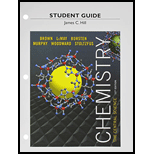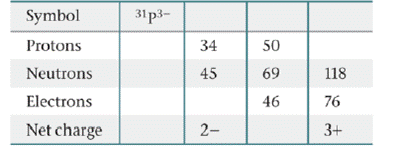
Study Guide for Chemistry: The Central Science
13th Edition
ISBN: 9780321949288
Author: Theodore E. Brown, James C. Hill
Publisher: PEARSON
expand_more
expand_more
format_list_bulleted
Concept explainers
Textbook Question
Chapter 11, Problem 17E
Fill in the gaps in the following table’

Expert Solution & Answer
Want to see the full answer?
Check out a sample textbook solution
Students have asked these similar questions
What is the IP for a amino acid- give an example
what are the types of amino acids
What are the structures of proteins
The N-Terminal analysis by the Edman method shows saralasin contains sarcosine at the N-terminus. Partial hydrolysis of saralasin with dilute hydrochloric acid yields the following fragments:
Try-Val-His
Sar-Arg-Val
His-Pro-Ala
Val- Tyr- Val
Arg-Val-Tyr
What is the structure of saralasin?
>
aw the missing intermediates 1 and 2, plus the final product 3, of this synthesis:
1. Eto
1. EtO¯
H3O+
1
2
2. PrBr
2. PrBr
Δ
You can draw the three structures in any arrangement you like.
3
Click and drag to start drawing a structure.
Explanation
Check
2025 McGraw Hill LLC. All Rights Reserved. Terms of Use
Privac
There are various factors that affect an equilibrium. Give 3 of these factors and explain using examples andequations how an equilibrium is affected by these factors. Please remember that this is a communication question so that you are communicating your understanding of the factors that affect and equilibrium.
Chapter 11 Solutions
Study Guide for Chemistry: The Central Science
Ch. 11.2 - Only two isotopes of copper occur naturally:63Cu...Ch. 11.2 - 2.36 Rubidium has two naturally occurring...Ch. 11.3 - a. Thomson’s cathode-ray tube (Figure 2.49) and...Ch. 11.3 -
2.38 Consider the mass spectrometer shown in...Ch. 11.4 - Naturally occurring magnesium has the following...Ch. 11.4 - Mass spectrometry is more often applied to...Ch. 11.5 - 2-41 For each of the following elements, write its...Ch. 11.5 - Locate each of the following elements in the...Ch. 11.6 - 2-43 For each of the following elements, write its...Ch. 11.6 - 2.44 The elements of group 4A show an interesting...
Ch. 11.7 - 2.45 The structural formulas of the compounds...Ch. 11.7 - 2.46 Ball-and-stick representations of benzene, a...Ch. 11 - Prob. 1DECh. 11 - 2.59 Using the periodic table to guide you,...Ch. 11 -
2.71 Name the following ionic compounds:
a....Ch. 11 -
2.83
What is a functional group?
What functional...Ch. 11 - The element lead (Pb) consists of four naturally...Ch. 11 - Prob. 5ECh. 11 - The molecules have the same molecular formula...Ch. 11 - A sample of an ionic compound containing iron and...Ch. 11 -
The compound dioxane, which is used as a solvent...Ch. 11 - If 3.00 g of titanium metal is reacted with 6.00 g...Ch. 11 -
2.48 Two substances have the same molecular and...Ch. 11 - 2.49 Write the empirical formula corresponding to...Ch. 11 - Determine the molecular and empirical formulas of...Ch. 11 - 251 How many hydrogen atoms are un each of the...Ch. 11 - Prob. 14ECh. 11 - 253 Write the molecular and structural formulas...Ch. 11 - 2-54 Write the molecular and structural formulas...Ch. 11 - Fill in the gaps in the following table’Ch. 11 - 2.56 Fill in the gaps in the following...Ch. 11 - Prob. 19ECh. 11 - Prob. 20ECh. 11 - Predict the chemical formulas of the compounds...Ch. 11 - Prob. 22ECh. 11 - Prob. 23ECh. 11 - Predict whether each of the following compounds is...Ch. 11 - 2.66 Which of the following are ionic, and which...Ch. 11 - Prob. 26ECh. 11 - Prob. 27ECh. 11 -
2.69 Give the names and charges of the cation and...Ch. 11 - Give the names and charges of the cation and anion...Ch. 11 - Prob. 30ECh. 11 -
Give the chemical formula for each of the...Ch. 11 -
2.75 Give the name or chemical formula, as...Ch. 11 - Prob. 33ECh. 11 -
2.T Give the name or Chemical formula, as...Ch. 11 - Prob. 35ECh. 11 - Prob. 36ECh. 11 - Assume that you encounter the following sentences...Ch. 11 - a. What is a hydrocarbon? b. Pentane is the alkane...Ch. 11 - Prob. 39ECh. 11 -
2.85 Chloropropane is derived from propane by...Ch. 11 - Prob. 41ECh. 11 - Suppose a scientist repeats the Millikan oil-drop...Ch. 11 -
2.88 The natural abundance of 3He is...Ch. 11 - A cube of gold that is 1.00 cm on a side has a...Ch. 11 -
2.90 The diameter of a rubidium atom is 4.95 A....Ch. 11 -
2.91
Assuming the dimensions of the nucleus and...Ch. 11 - (a) What is the significance of the critical...Ch. 11 -
2.93 The nucleus of 6Li is a powerful absorber of...Ch. 11 - The element oxygen has three naturally occurring...Ch. 11 - Using a suitable reference such as the CRC...Ch. 11 - There are two different isotopes of bromine atoms....Ch. 11 -
2.99 It is common in mass spectrometry to assume...Ch. 11 - From the following list of elements—Ar, H, Ga, Al,...Ch. 11 - Prob. 54ECh. 11 -
2.102 The explosion of an atomic bomb releases...Ch. 11 - Prob. 56ECh. 11 - Prob. 57ECh. 11 -
2.105 From the molecular structures shown here,...Ch. 11 -
2.106 Name each of the following oxides. Assuming...Ch. 11 - Prob. 60ECh. 11 - Prob. 61ECh. 11 - Give the chemical names of each of the following...Ch. 11 -
2.112 Many familiar substances have common,...Ch. 11 -
2.113 Because many ions and compounds have very...Ch. 11 -
2.114 In what part of the atom does the strong...Ch. 11 - In the following diagram, the white spheres...Ch. 11 - In the following digram, the white spheres...Ch. 11 - Prob. 68ECh. 11 - Balance these equations by providing the missing...Ch. 11 - Write the balanced equation for the reaction that...Ch. 11 - Prob. 71ECh. 11 - Which of the following is the correct formula...Ch. 11 - Prob. 73AECh. 11 - Prob. 74AECh. 11 - Calculate the percentage of potassium by mass in...Ch. 11 - Which of the following samples contains the fewest...Ch. 11 - In dichloromethane, CH2Cl2 (= 1.60D)), the...Ch. 11 - Prob. 78AECh. 11 -
How many oxygen atoms are in (a) 0.25 mol...Ch. 11 - Prob. 80AECh. 11 - Prob. 81AECh. 11 - What is the mass, in grams, of 6.33 mol of NaHC03...Ch. 11 - What is the mass, in grams, of (a) 0.50 mol of...Ch. 11 - How many chlorine atoms are in 12.2 g of CCL4? a....Ch. 11 -
a. How many nitric acid molecules are in 4.20 g...Ch. 11 - A 2.144-g sample of phosgene, a compound used as a...Ch. 11 - A 5.325-g sample of methyl benzoate, a compound...Ch. 11 -
Cyclohexane a commonly used organic solvent, is...Ch. 11 - Prob. 89AECh. 11 - Prob. 90IECh. 11 - Decomposition of KCIO3 is sometimes used to...Ch. 11 - Propane, C3 H8 (Figure 3.8), is a common fuel used...Ch. 11 -
Methanol, CH3OH, reacts with oxygen from air in a...Ch. 11 - When 24 mol of methanol and 15 mol of oxygen...Ch. 11 - a. When 1.50 mol of Al and 3.00 mol of Cl2 combine...Ch. 11 - Molten gallium reacts with arsenic to form the...Ch. 11 -
When a 2.00-g strip of zinc metal is placed in...
Knowledge Booster
Learn more about
Need a deep-dive on the concept behind this application? Look no further. Learn more about this topic, chemistry and related others by exploring similar questions and additional content below.Similar questions
- EEZE LETCHUP ID Draw the most likely conjugate base resulting from this acid-base reaction. Include all lone pairs. Ignore inorganic byproducts. Drawing く NaOCH2CH3 :0: :0: 狗arrow_forwardAnswerarrow_forward2. Provide a clear arrow-pushing mechanism for the following reactions. Do not skip proton transfers, do not combine steps, and make sure your arrows are clear enough to be interpreted without ambiguity. a. CH3 Ph OEt هد Ph CH3 Hint: the species on the left is an ynolate, which behaves a lot like an enolate.arrow_forward
- b. CH3 H3C CH3 CH3 H3C an unexpected product, containing a single 9- membered ring the expected product, containing two fused rings H3C-I (H3C)2CuLi an enolatearrow_forwardb. H3C CH3 1. 2. H3O+ H3C MgBr H3Carrow_forwardPredict the major products of this reaction: excess H+ NaOH ? A Note that the first reactant is used in excess, that is, there is much more of the first reactant than the second. If there won't be any products, just check the box under the drawing area instead. Explanation Check Click and drag to start drawing a structure. © 2025 McGraw Hill LLC. All Rights Reserved. Terms of Use Privarrow_forward
- 1. For each of the reaction "railroads" below, you are either asked to give the structure(s) of the starting material(s) or product(s), or provide reagents/conditions to accomplish the transformation, as indicated by the boxes. a. NaOMe H+ .CO,H HO₂C MeOH (excess) MeOH H3C Br يع CH3 1. LiAlH4 2. H3O+ 3. PBг3 H3C 1. Et-Li 2. H3O+ -CO₂Me -CO₂Me OH CH3 CH3 ল CH3arrow_forwardPredict the intermediate 1 and final product 2 of this organic reaction: NaOMe ག1, ད།་, - + H You can draw 1 and 2 in any arrangement you like. 2 work up Note: if either 1 or 2 consists of a pair of enantiomers, just draw one structure using line bonds instead of 3D (dash and wedge) bonds at the chiral center. Explanation Check Click and drag to start drawing a structure. Х © 2025 McGraw Hill LLC. All Rights Reserved. Terms of Use | Parrow_forwardWhat is the total energy cost associated with the compound below adopting the shown conformation? CH3 HH DH CH3arrow_forward
- ΗΝ, Draw Final Product C cyclohexanone pH 4-5 Edit Enamine H3O+ CH3CH2Br THF, reflux H Edit Iminium Ionarrow_forwardHow many hydrogen atoms are connected to the indicated carbon atom?arrow_forwardIdentify the compound with the longest carbon - nitrogen bond. O CH3CH2CH=NH O CH3CH2NH2 CH3CH2C=N CH3CH=NCH 3 The length of all the carbon-nitrogen bonds are the samearrow_forward
arrow_back_ios
SEE MORE QUESTIONS
arrow_forward_ios
Recommended textbooks for you
 Chemistry: Principles and ReactionsChemistryISBN:9781305079373Author:William L. Masterton, Cecile N. HurleyPublisher:Cengage Learning
Chemistry: Principles and ReactionsChemistryISBN:9781305079373Author:William L. Masterton, Cecile N. HurleyPublisher:Cengage Learning Chemistry: Principles and PracticeChemistryISBN:9780534420123Author:Daniel L. Reger, Scott R. Goode, David W. Ball, Edward MercerPublisher:Cengage Learning
Chemistry: Principles and PracticeChemistryISBN:9780534420123Author:Daniel L. Reger, Scott R. Goode, David W. Ball, Edward MercerPublisher:Cengage Learning Chemistry for Engineering StudentsChemistryISBN:9781285199023Author:Lawrence S. Brown, Tom HolmePublisher:Cengage Learning
Chemistry for Engineering StudentsChemistryISBN:9781285199023Author:Lawrence S. Brown, Tom HolmePublisher:Cengage Learning Chemistry for Engineering StudentsChemistryISBN:9781337398909Author:Lawrence S. Brown, Tom HolmePublisher:Cengage Learning
Chemistry for Engineering StudentsChemistryISBN:9781337398909Author:Lawrence S. Brown, Tom HolmePublisher:Cengage Learning Chemistry: An Atoms First ApproachChemistryISBN:9781305079243Author:Steven S. Zumdahl, Susan A. ZumdahlPublisher:Cengage Learning
Chemistry: An Atoms First ApproachChemistryISBN:9781305079243Author:Steven S. Zumdahl, Susan A. ZumdahlPublisher:Cengage Learning Chemistry: The Molecular ScienceChemistryISBN:9781285199047Author:John W. Moore, Conrad L. StanitskiPublisher:Cengage Learning
Chemistry: The Molecular ScienceChemistryISBN:9781285199047Author:John W. Moore, Conrad L. StanitskiPublisher:Cengage Learning

Chemistry: Principles and Reactions
Chemistry
ISBN:9781305079373
Author:William L. Masterton, Cecile N. Hurley
Publisher:Cengage Learning

Chemistry: Principles and Practice
Chemistry
ISBN:9780534420123
Author:Daniel L. Reger, Scott R. Goode, David W. Ball, Edward Mercer
Publisher:Cengage Learning

Chemistry for Engineering Students
Chemistry
ISBN:9781285199023
Author:Lawrence S. Brown, Tom Holme
Publisher:Cengage Learning

Chemistry for Engineering Students
Chemistry
ISBN:9781337398909
Author:Lawrence S. Brown, Tom Holme
Publisher:Cengage Learning

Chemistry: An Atoms First Approach
Chemistry
ISBN:9781305079243
Author:Steven S. Zumdahl, Susan A. Zumdahl
Publisher:Cengage Learning

Chemistry: The Molecular Science
Chemistry
ISBN:9781285199047
Author:John W. Moore, Conrad L. Stanitski
Publisher:Cengage Learning
Step by Step Stoichiometry Practice Problems | How to Pass ChemistryMole Conversions Made Easy: How to Convert Between Grams and Moles; Author: Ketzbook;https://www.youtube.com/watch?v=b2raanVWU6c;License: Standard YouTube License, CC-BY